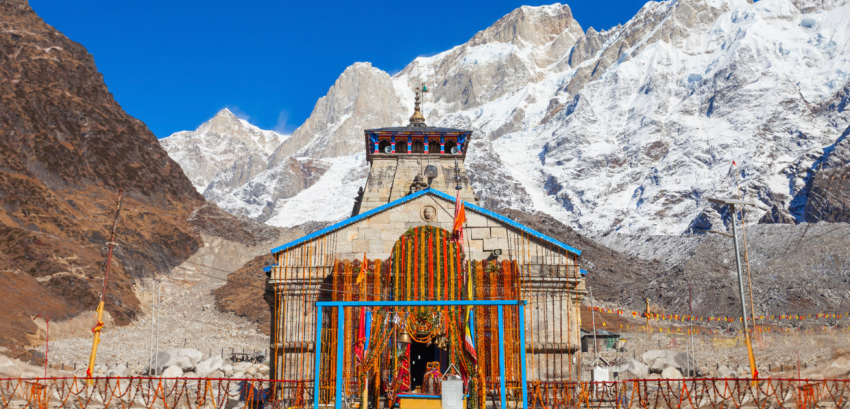Exploring Kedarnath A Journey to the Sacred Himalayan Abode

Exploring Kedarnath: A Journey to the Sacred Himalayan Abode
Nestled in the lap of the majestic Garhwal Himalayas, Kedarnath is one of the holiest destinations for Hindus and a remarkable place for nature lovers and adventure enthusiasts. Renowned for the sacred Kedarnath Temple, this pilgrimage town offers breathtaking views, spiritual solace, and thrilling trekking experiences. This guide will take you through the essentials of traveling to Kedarnath, exploring its spiritual significance, natural beauty, and practical travel tips.
Spiritual Significance
Kedarnath, situated in the Rudraprayag district of Uttarakhand, is one of the twelve Jyotirlingas of Lord Shiva, making it a significant pilgrimage site in Hinduism. The Kedarnath Temple, dedicated to Lord Shiva, is believed to have been built by the Pandavas and later reconstructed by Adi Shankaracharya in the 8th century.
Kedarnath Temple
The temple is the primary attraction in Kedarnath. Located at an altitude of 3,583 meters (11,755 feet), it is an architectural marvel constructed from massive stone slabs. The temple stands amidst snow-capped peaks and lush green valleys, creating a serene and awe-inspiring atmosphere.
The temple’s main deity is a conical rock formation representing Lord Shiva in his “Sadashiva” form. Pilgrims from all over the world visit Kedarnath to seek blessings and offer prayers. The temple is open from April to November, with the opening and closing dates determined by the priests based on the Hindu lunar calendar.
Natural Beauty and Trekking
Kedarnath is not only a spiritual hub but also a paradise for nature enthusiasts. The trek to Kedarnath offers stunning views of the Himalayas, dense forests, and gushing rivers, making it a memorable journey for trekkers and adventure seekers.
The Kedarnath Trek
The trek to Kedarnath starts from Gaurikund, a small town about 16 kilometers (10 miles) from the temple. Gaurikund is accessible by road from major cities like Rishikesh, Haridwar, and Dehradun. The trek is moderately challenging and takes around 6-7 hours to complete.
Trekking Route and Tips
- Gaurikund to Jungle Chatti (4 km): The trek begins with a gradual ascent through lush green forests and alongside the Mandakini River. Jungle Chatti is the first stop, where trekkers can rest and enjoy the natural surroundings.
- Jungle Chatti to Bheembali (3 km): The next stretch involves a slightly steeper climb. Bheembali offers basic facilities like food and rest areas.
- Bheembali to Linchauli (4 km): The path continues to ascend, with picturesque views of the mountains. Linchauli is another rest point with accommodation options.
- Linchauli to Kedarnath Base Camp (5 km): The final leg of the trek is the most challenging but also the most rewarding, with the Kedarnath Temple coming into view as you approach the base camp.
Trekking Tips:
- Start early to avoid the afternoon heat and potential weather changes.
- Wear comfortable trekking shoes and carry essentials like water, snacks, and a first-aid kit.
- Acclimatize properly to the altitude to prevent altitude sickness.
- Be mindful of the weather, as conditions can change rapidly in the mountains.
Alternative Route: Helicopter Service
For those unable to trek, helicopter services are available from Phata, Guptkashi, and Sirsi. These services provide a quick and scenic way to reach Kedarnath, offering stunning aerial views of the Himalayas.
Accommodation and Facilities
Kedarnath offers a range of accommodation options, from budget guesthouses to more comfortable hotels. During the peak pilgrimage season, it is advisable to book accommodations in advance.
Accommodation Options
- GMVN (Garhwal Mandal Vikas Nigam) Guesthouses: These government-run guesthouses are reliable and offer basic facilities.
- Dharamshalas: Various charitable trusts run dharamshalas that provide affordable accommodation to pilgrims.
- Private Hotels: A few private hotels offer more amenities and comfort but can be more expensive.
Food and Supplies
Several small restaurants and food stalls in Kedarnath and along the trekking route serve simple vegetarian meals. It is recommended to carry some dry snacks and water, especially during the trek.
Best Time to Visit
The best time to visit Kedarnath is between May and October. During these months, the weather is relatively mild and the temple is accessible. The region experiences heavy snowfall in winter, and the temple remains closed from November to April.
Weather Considerations
- Summer (May to June): Pleasant weather with clear skies, making it ideal for trekking and sightseeing.
- Monsoon (July to September): Heavy rainfall can lead to landslides and challenging trekking conditions. It is advisable to avoid this season.
- Autumn (October): Clear weather and vibrant fall colors make it a beautiful time to visit. The temple closes after Diwali.
Local Culture and Customs
Understanding the local culture and customs can enhance your travel experience in Kedarnath.
Pilgrimage Etiquette
- Respect the Sanctity: Dress modestly and respect the sanctity of the temple and surrounding areas.
- Photography: Photography inside the temple is prohibited. Be mindful of where you take photos.
- Environmental Responsibility: Help keep the area clean by disposing of waste properly and following eco-friendly practices.
Festivals and Events
Attending local festivals can provide insight into the region’s rich cultural heritage. The most significant event is the opening and closing ceremonies of the Kedarnath Temple, which involve elaborate rituals and attract numerous devotees.
Safety and Health Tips
Traveling to high-altitude regions like Kedarnath requires certain precautions to ensure a safe and healthy journey.
Health Tips
- Hydration: Stay hydrated to combat altitude sickness.
- Acclimatization: Spend a day acclimatizing at lower altitudes before starting the trek.
- Medication: Carry necessary medications and consult a doctor if you have pre-existing health conditions.
Safety Tips
- Weather Awareness: Keep an eye on weather forecasts and be prepared for sudden changes.
- Trekking Gear: Use appropriate trekking gear, including sturdy shoes, warm clothing, and rain protection.
- Emergency Contacts: Keep emergency contacts handy and inform someone about your trekking plans.
Conclusion
Kedarnath is a destination that offers a unique blend of spiritual enrichment and natural beauty. Whether you are a pilgrim seeking divine blessings, a trekker looking for adventure, or a nature lover drawn to the pristine Himalayan landscapes, Kedarnath has something to offer everyone. By understanding the spiritual significance, preparing for the trek, and respecting local customs, you can make your journey to Kedarnath a fulfilling and memorable experience.






